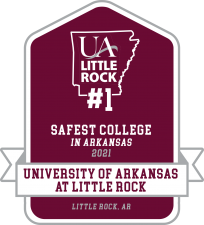The Student Right-to-Know and Campus Security Act of 1990 was revised as the “The Jeanne Clery Disclosure of Campus Security Policy and Crime Statistics Act of 1998” with additional revisions under the 2008 Reauthorization of Higher Education Opportunity Act.
UA Little Rock crime statistics are prepared and distributed annually to current and prospective faculty, staff, and students. The report is a list on the UA Little Rock website and persons requesting a paper copy of the report can contact UA Little Rock Police Department for a copy.
In accordance with this act, UA Little Rock campus security reporting authority is the UA Little Rock Police Department and the Office of the Dean of Students.
University offices and individuals with significant responsibility for student and campus activities are canvassed to assure full compliance and inclusion regarding confidential reporting and the collection of crime statistics for this report, those personnel are Campus Security Authorities or CSA’s.
Crimes are classified according to definitions provided by the FBI Uniform Crime Report. Anonymous reports of crimes are investigated to determine their validity. If substantiated they are reported in the proper category. If unsubstantiated they are reported categorically. Individuals may report sexual assaults anonymously.
Additionally, the 2008 Higher Education Opportunity Act regulations include:
- Expansion of the categories of hate crime reporting to include the crimes of larceny-theft, simple assault, intimidation, and destruction/damage /vandalism of property. A hate crime is a crime that manifests evidence that the victim was selected based on the perpetrator’s bias against race, ethnicity, religion, gender, sexual orientation, disability, or age.
- Statements of policy regarding emergency response and evacuation procedures are required. The statements must include procedures to immediately notify the campus community of a significant emergency or immediate threat to the campus community and who has the responsibility for sending the notification, and procedures for testing the systems. This requirement does not replace the timely warning requirement for criminal events. The emergency notification requirement covers a broader category of threats (such as chemical spills, tornado, earthquake). A statement must be included regarding the procedures the University will use to test the emergency evacuation procedures at least annually. A description of the exercise, the date and time it occurred, and whether it was announced or unannounced must be included.
- Institutions of higher education are required to include in the Annual Security Report statistics for each on-campus student housing facility, including the number of injuries and deaths related to the fires, the value of property damage caused by fires, and the date and time and general location of the fire. A description of each on-campus student housing facility’s fire safety systems and the number of mandatory supervised fire drills. Policies or rules on portable electronic appliances, smoking, and open flames and evacuation procedures must also be included. In addition, the frequency and type of fire safety education and training programs provided to students, staff, and faculty must be documented. Also included is any plan(s) for fire safety improvements, if needed. This information will be provided annually in this report.
- Institutions of higher education with on-campus housing are required to include the policy and procedure for reporting students missing who reside in on-campus housing that has been missing for 24 hours. The policy includes the persons to which individuals should report missing students, that local law enforcement will be notified of missing students, that students 18 and may register a confidential contact person if they are reported missing, that the parents of students under 18 will be notified and the specific procedures the institution will follow if a student is reported missing.
- The Safety and Health-Related Resources, Counseling, and University Programs section describes police agencies, on-campus support services, off-campus support services, and University programs that address issues of safety, health, mental health, conflict, and conflict resolution.
